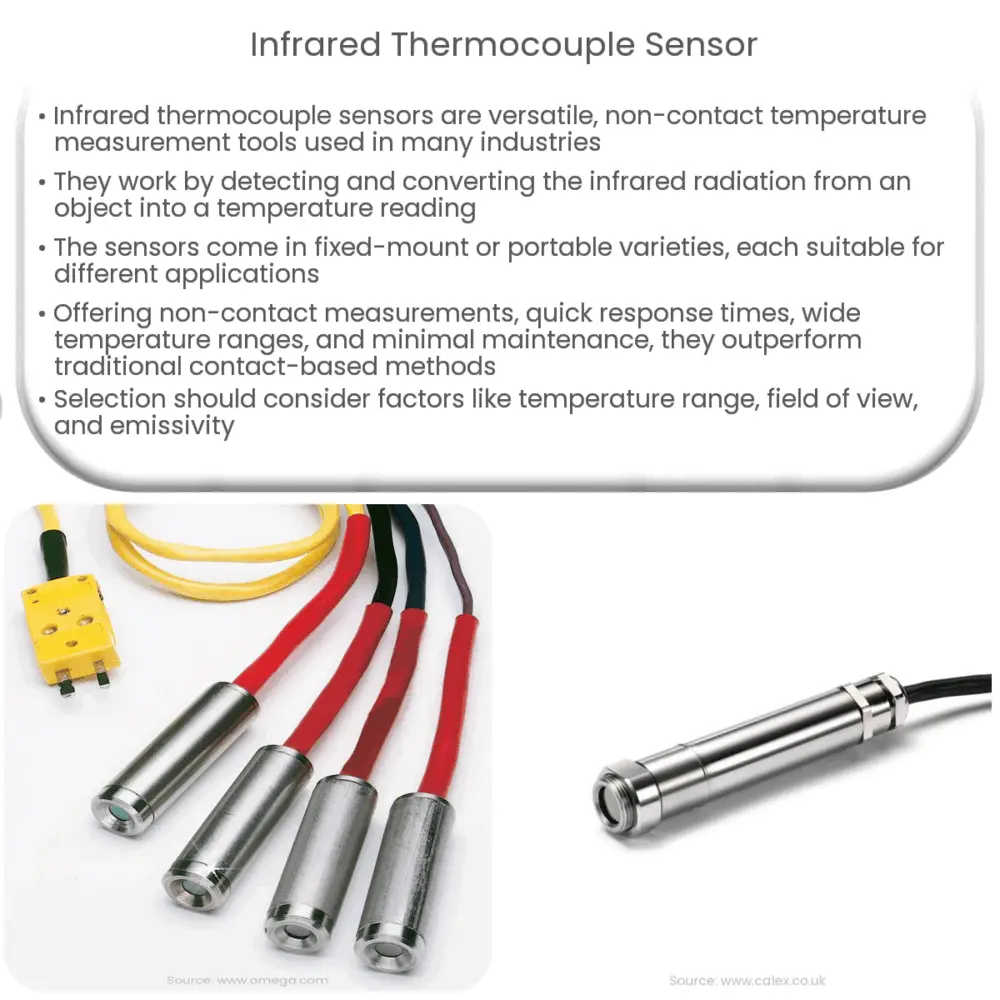Infrared thermocouple sensors are non-contact temperature measurement devices used in various industries, offering fast, accurate readings and minimal maintenance.

Infrared Thermocouple Sensors: A Comprehensive Overview
Introduction
In the world of temperature measurement, infrared thermocouple sensors have emerged as a powerful and versatile tool. These sensors are widely used in various industries, including manufacturing, automotive, aerospace, and food processing, thanks to their unique capabilities and benefits. In this article, we will explore the inner workings of infrared thermocouple sensors, their applications, and the advantages they bring to temperature measurement.
How Infrared Thermocouple Sensors Work
Infrared thermocouple sensors, also known as IR thermocouples, are non-contact temperature measurement devices that work by detecting the infrared radiation emitted by an object. All objects with a temperature above absolute zero emit infrared radiation, and the amount of radiation emitted is proportional to the object’s temperature. An infrared thermocouple sensor is equipped with a special detector that can measure the intensity of this radiation, and then convert it into a temperature reading.
The sensor’s detector is typically a thermopile, which is made up of several thermocouples connected in series. When infrared radiation strikes the thermopile, it generates a small voltage proportional to the radiation’s intensity. This voltage is then processed by the sensor’s electronics, which calculate the object’s temperature using the known relationship between radiation intensity and temperature.
Types of Infrared Thermocouple Sensors
There are two main types of infrared thermocouple sensors: fixed-mount and portable. Each type has its own set of benefits and is suited to specific applications.
1. Fixed-Mount Infrared Thermocouple Sensors
Fixed-mount infrared thermocouple sensors are permanently installed in a specific location and provide continuous temperature monitoring. These sensors are ideal for use in situations where regular temperature checks are required, such as monitoring equipment and processes in manufacturing plants or ensuring the correct temperature is maintained in a food production facility.
2. Portable Infrared Thermocouple Sensors
Portable infrared thermocouple sensors, often referred to as infrared thermometers or pyrometers, are handheld devices that allow users to take temperature readings on-the-go. These devices are popular in industries where spot-checking of temperatures is necessary, such as automotive repair or HVAC maintenance.
Applications of Infrared Thermocouple Sensors
Infrared thermocouple sensors have a wide range of applications across various industries. Some common uses include:
- Monitoring temperature in manufacturing processes, such as plastic injection molding, metal forging, or glass production
- Measuring the temperature of moving objects, such as conveyor belts or rotating machinery
- Ensuring food safety by monitoring cooking and storage temperatures
- Checking the temperature of electrical components in automotive and aerospace industries
- Assessing the efficiency of heating, ventilation, and air conditioning (HVAC) systems
Advantages of Infrared Thermocouple Sensors
Infrared thermocouple sensors offer several key advantages over traditional contact-based temperature measurement methods:
- Non-contact measurement: Since infrared thermocouple sensors measure temperature without physical contact, they can be used in situations where contact methods would be impractical, dangerous, or could potentially damage the object being measured.
- Fast response time: Infrared thermocouple sensors can measure temperature changes rapidly, often within milliseconds, making them suitable for monitoring dynamic processes and detecting temperature anomalies quickly.
- Wide temperature range: These sensors can measure a broad range of temperatures, from extremely low cryogenic levels to extremely high furnace temperatures, making them versatile for various applications.
- Minimal maintenance: Due to their non-contact nature, infrared thermocouple sensors do not suffer from wear and tear caused by physical contact, resulting in a longer lifespan and reduced maintenance requirements.
Selecting the Right Infrared Thermocouple Sensor
When choosing an infrared thermocouple sensor, several factors should be considered to ensure the best performance for the intended application:
- Temperature range: Ensure the sensor can measure the temperature range required for your specific application.
- Field of view (FOV): The sensor’s FOV determines the size of the area it can measure. A larger FOV is suitable for measuring larger surfaces or objects, while a smaller FOV provides higher accuracy for smaller targets.
- Emissivity: Emissivity is a measure of how efficiently an object emits infrared radiation. Ensure the sensor is compatible with the emissivity of the materials you will be measuring.
- Response time: Choose a sensor with a response time that meets the requirements of your application, especially if you need to monitor fast-changing temperatures.
- Installation and mounting requirements: Consider the physical constraints of your application, such as available space and mounting options, when selecting a sensor.
Conclusion
Infrared thermocouple sensors have revolutionized temperature measurement across numerous industries by offering non-contact, fast, and accurate temperature monitoring. With a broad range of applications and significant advantages over traditional contact-based methods, these sensors continue to play a vital role in ensuring the quality, safety, and efficiency of various processes and products. By carefully considering factors such as temperature range, field of view, emissivity, response time, and installation requirements, you can select the ideal infrared thermocouple sensor for your specific needs.

